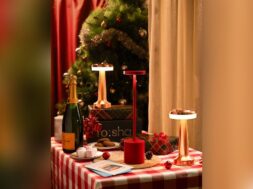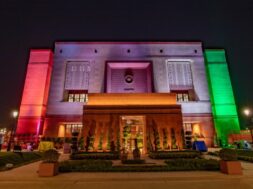Apart from well-designed interiors, lighting too is one of the key areas to look at to create the right kind of mood and ambience, Avni Sejpal, Design Head at Studio Avni tells Vikas Bhadra
What is your idea of good design?
Good Design should be able to blend contemporary visual influences and traditional craftsmanship to create pieces that are unique, contextual and timeless. Over and above this, these products should exude a character or an emotional quotient, in the sense it should evoke an emotion or be experiential.
The designed product needs to have a lasting value which isn’t really trend based, hence it needs to be very intimate and have a personality at a certain level so that it does not land up in trash after a few years.
When it comes to light design does the definition remain same or get altered? Is it a static idea or a dynamic one?
I think lighting design is in such a special place – sweet spot, it’s a functional sculpture. It can create an ebb and flow of emotion in the space. If done well, it can reinforce specific emotional responses and opens up the space to experienced in myriad ways. Lighting is not like furniture or any other product; it literally has an effect on how we use everything in the space. Just like music, light can set the tone of a space and emotionally put you in a Zen space. So in a way it’s an intangible material but essentially it’s about creating forms so that we can achieve optimum results with the given medium.
With increasing globalisation how has it altered the taste of Indians when it comes to designer lighting?
Lighting is a hugely overlooked aspect of design but with so much to offer. Light pieces are more like focal points and functional sculptures that can either make or break your space. But that’s changing, as now there is a general awareness in using energy efficient light source – LEDS that are kinder to the environment. People are ready to invest in more quality and one of a kind custom lights rather than mass-produced ones. They understand the value of something specially made for the space that could completely transform the space.
In terms of materials, warmer metals such as copper, bronze, brass and gold tones are making their presence. It’s like a jewellery piece to the space, making it warm, chic and understated all at once. Lighting inspired by nature softens the feel of cold, contemporary or bare spaces by adding softer lines and an organic feel to the room.
When it comes to selecting the right lights for your living and commercial spaces, how does one do that, what advice would you give to our readers?
Unless architects/ designers intervene, lighting design is the most neglected area. Lighting is literally another material to create a mood for your space. The right light fixture can create warm cosy corners and also add a personality to the space. Every space has its unique set of requirements. There are many factors that have to be accounted for and which are not same for all spaces such as scale, proportion, day light quality and overall language of the space.
Before zeroing down on a particular light fixture, one must consider all these factors.
When it comes to interior lighting for residential vs commercial spaces, what is the line of difference between the two?
Lighting is a very crucial aspect of every home! It can make or break a space. A good light piece would essentially tie up the space together. Commercial and residential have very different programmatic needs and usage. There are several factors that influence these from purpose, traffic, cost, durability, materials, and mode of maintenance. Light fixtures in both spaces perform diverse functions. Colour temperatures play a very significant role as well. For office lighting, for instance, to avoid strain on eyes, light bulbs with 4000k colour temperature is generally used. Just like Kitchen, which because of its functionality should be brighter. However, for creating relaxing spaces such as bedroom and lounging space, a general lighting design of 3000k colour temperature will be perfect.
What are the different materials you have flirted with to design your products?
I experiment with a lot of different materials and push their boundaries before I decide the final materials. It’s also interesting to see how different materials influence one another. The idea of role reversal of materials wherein hard materials such as metal would behave in a delicate manner almost like paper or fluid or textiles to reminiscent something more structured and permanent is very intriguing. I love exploring this idea.
Having said that I’m a little partial towards metals and textiles. My mother always used to have pure material products in her kitchen, from the quintessential copper Lota to brass Sev Sancha, brass Uruli, water decanters in copper or Kansu dinnerware among many others. I think that has stayed with me and probably that’s why I prefer using a lot of pure metals rather than plating them or coating them – it also increases their shelf life. Golden hues from brass are both bright and luxurious and its lively yellow colour is capable of making your room bright shine as the sun. Copper is a surprisingly warm and subtle alternative to the expected steel accents. With its red and orange tones and overall earthy hue, copper is a much-needed breath of fresh air. They exude so much warmth! Natural materials such as wood, cork, marble and metals such as German silver and pewter are also something I love experimenting with. These elements help bring an organic and serene ambiance to any space while reflecting the world around your home. This year, I will be experimenting a lot with fabrics for lighting.
As a light designer you have worked on different projects, can you cite an example of one project, which offered you a great deal of personal and professional gratification?
Collaborating is fascinating. With every bespoke commission, there is always a learning curve. Generally, the architects and clients usualy provide me with images and drawings of the space and a material palette along with a list of their references. These references are further discussed and then research and ideated over which I would try and interpret it in my way. That way I am always learning and discovering new things that go on to inspire and appear in my work as I create.
One such really exciting collaboration was with Incubis Architects, New Delhi. We designed a group of coastal sculptures in copper for a client in Kochi. The whole process was very exciting, in terms of ideation, the process, mocks. It was a perfect blend of parametric designing and handcrafted product. The resulting visual impact was extraordinary. It was a lot of fun essentially!
What are some of the popular products in your product portfolio?
Faceted series and Fin series, it just seems to reinvent itself every time with a new brief. I view these collections more like applications and not set in stone. There are a multiple ways that I would be able to use them just by tweaking scale and design.
What are some of the ongoing projects you are working on? What events you will be participating in the current year?
There are a few installations for some stores, private residences and corporate headquarters, which are in the pipeline along with a brand new collection. So I am keeping my fingers crossed!
Avni Sejpal,
Design Head at Studio Avni
6
Cookie Consent
We use cookies to personalize your experience. By continuing to visit this website you agree to our Terms & Conditions, Privacy Policy and Cookie Policy.









